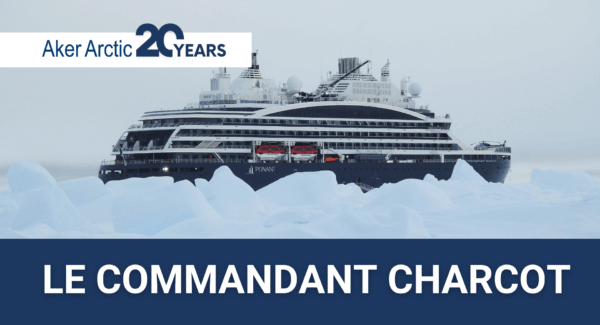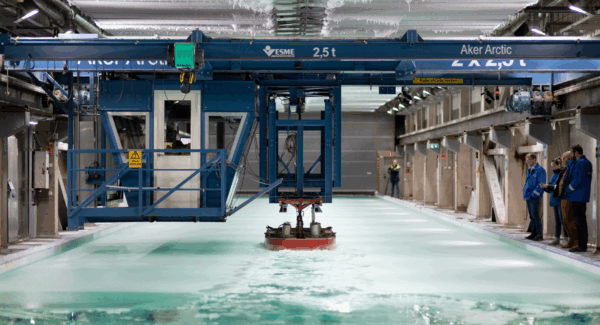Navigating the future of icebreaking design
Aker Arctic’s Managing Director, Mika Hovilainen, reflects on how evolving market demands and emerging trends are increasing vessel complexity and reshaping icebreaking ship design through new areas of technical proficiency.

Modern ships incorporate intricate systems to meet today’s energy efficiency and emission requirements, including emission reduction systems, energy storage solutions, and alternative fuel options.
Compliance with stricter regulations requires more intensive technical work, such as analyses, calculations, and investigations. Optimising hull forms, machinery, and overall design to improve energy efficiency and safety have become the new standards.
“Technologically, vessels are becoming increasingly complex and even small gains in energy efficiency are valuable to save costs,” Hovilainen says. “The fact is, we can no longer build the same ships as we did 20 years ago.”

Growing importance of technical expertise
Looking ahead, Hovilainen emphasises the growing importance of advanced technical expertise. With an expanding array of design options, selecting the optimal solution for each ship requires in-depth knowledge and experience.
“At Aker Arctic, completing multiple icebreaking ship design concepts annually ensures we remain at the forefront of the industry. Every project has novel features and demands which challenge us every day,” Hovilainen explains.
For shipyards, streamlining the construction process will remain vital to control costs. However, increasingly complex regulations are a challenge and cooperating with an experienced and skilled ship designer helps to reduce risks related to rapid changes in technology and regulations.
“The shift to goal-based regulations will also add new aspects as requirements can be achieved with alternative technical solutions,” Hovilainen says.
A lifecycle approach to cost management
Icebreakers typically have long lifespans and investment decisions consider far more than just the initial acquisition price.
“Taking into account the costs and emissions for a vessel’s entire lifetime already in the concept design has become common practice,” Hovilainen observes. “This requires a new approach to ship design where the operational understanding is highlighted.”
He adds that in icebreaking, reducing operational costs also means reducing emissions. When tasks are completed more energy-efficiently, both financial and environmental benefits follow.
Toward a fossil-free future
As emission regulations continually tighten to combat greenhouse gas emissions, fossil-free fuels are essential in the long-term. Through improved energy efficiency, negative impacts of alternative fuels, such as lower energy density, are reduced.
Hovilainen expects rising fuel prices to influence transportation economics.
“Ships are already operating at slower speeds to comply with EEDI regulations, reduce emissions, and save fuel, and this trend will increase,” he says.
Hovilainen also anticipates ship sizes to grow while transporting greater cargo volumes to achieve lower fuel consumption per cargo unit.
“To support this development, we have explored scenarios where large commercial vessels follow smaller icebreakers. Our innovative solutions ensure effective winter navigation in the Baltic Sea for the future,” Hovilainen assures.
He points to an alternative approach: deploying small nuclear reactors. Though costly to install, they enable an opposite optimisation of marine transportation systems, as operation costs do not depend heavily on the power used.
A reliable winter navigation system
Aker Arctic is keen on addressing emissions in winter navigation, particularly for commercial shipping in the Baltic Sea.
“Finnish exports and imports rely on a smooth winter navigation system. Our mission is to ensure it continues to be efficient, sustainable, and safe,” Hovilainen says.
The Baltic icebreaking fleet will require replacement within the next decade, and Aker Arctic is ready to support the development of next-generation designs for Finland, Sweden, and Estonia.
Hovilainen also stresses the need to improve the energy efficiency of cargo ships without increasing icebreaking demands, which would shift the burden onto icebreakers. Instead, optimising the entire transportation system is vital. This includes better collaboration between cargo ships and icebreakers to create a reliable and safe system.
Finland recently signed a Memorandum of Understanding with Canada and the United States to increase collaboration on icebreaker projects.
“We will certainly support the development to improve Arctic capabilities,” Hovilainen says.
Tools for optimisation and safety
In addition to designing icebreakers and ice-capable vessels, Aker Arctic is developing tools to optimise routes and transportations in icy conditions as part of its transit simulation services. This can help both in early decision-making and in operations.
“We are looking to integrate real-time environmental data with specific vessels to optimise routes for each transportation task. The same tools also help to identify the best vessel design for a specific route,” Hovilainen explains.
Recently, several new contracts for Aker Arctic’s Ice Load Monitoring System (ARC ILMS) have been published. This system measures structural loads experienced by ships operating in ice-covered waters, enhancing safety in winter navigation and providing guidance to the crew. The key know-how lies not in the actual measurements but in understanding how structures respond to ice loads and calibrating the system correctly.
Strengthening leadership
Over the past two decades, Aker Arctic has designed a significant portion of the world’s icebreaking vessels, each constructed and proven effective in operation. Every project has introduced new challenges, leading to innovative solutions.
“Our plan for the coming decade is to continue to advance our expertise, strengthening our leadership in this niche, and deliver solutions that prioritise sustainability and safety for all vessels navigating icy waters,” Hovilainen summarises.
Text by Catarina Stewen

